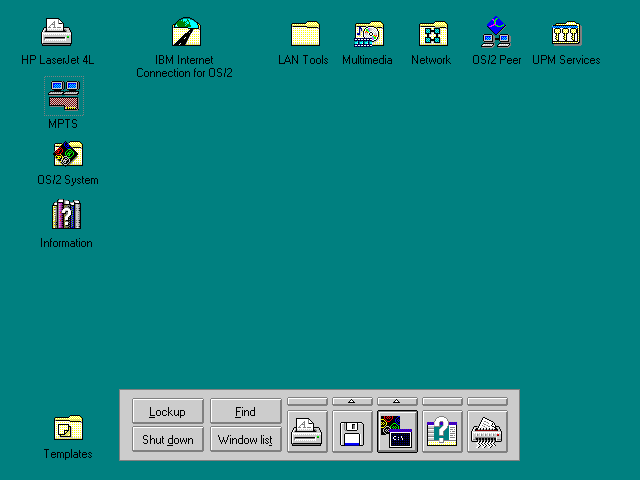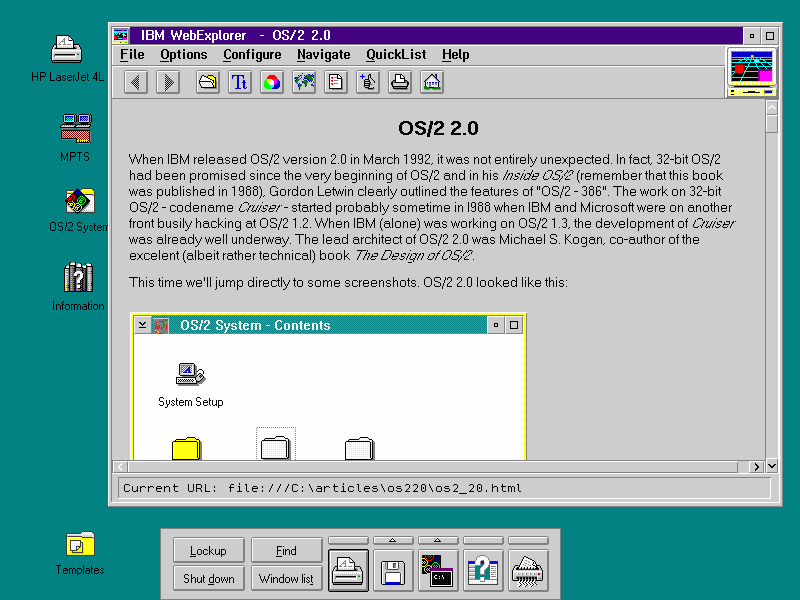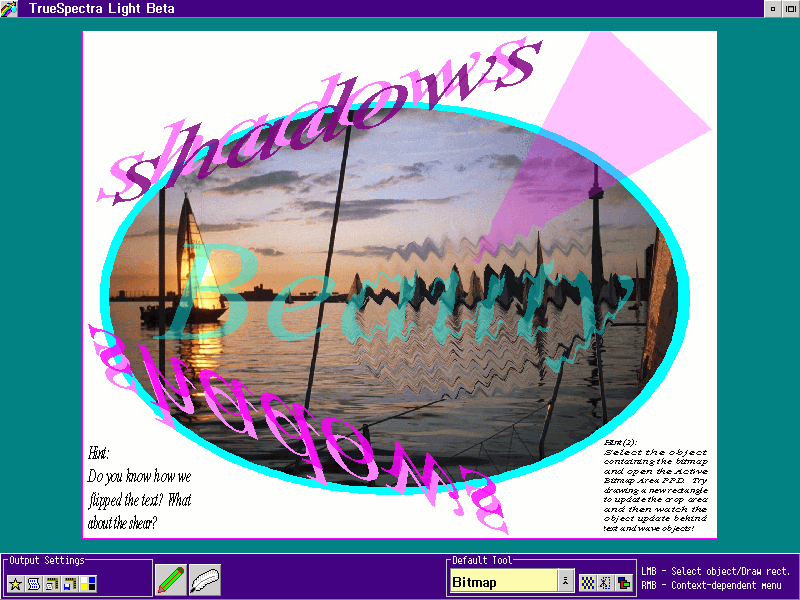
In October 1994 IBM released OS/2 Warp, the most popular version
of OS/2 and arguably one of the coolest operating systems ever (Warp Connect
even said so on the box - "The totally cool way to run and network your
computer" so it must be true). It was so good that some people use it even
today - not me though, or at least not seriously. Its underpinnings weren't
all that different from OS/2 version 2.11 but it was a great leap forward
in terms of usability.
OS/2 Warp was also IBM's most serious and best attempt at gaining dominance on the desktop, or at least significant marketshare. I've heard that at one point OS/2 Warp may have commanded as much as 10% of the desktop market, but it is extremely difficult if not impossible to get reliable figures - if indeed anyone has them in the first place, which I doubt. This attempt for grabbing greater marketshare was moderately successful and many people were attracted to Warp. I was among them too and OS/2 Warp was the first version of OS/2 that I installed on my machine in 1995 (then a Pentium 90, originally with 8MB and quickly upgraded to 16 and later 32MB RAM) and I have fond memories of that era.
Similarly to OS/2 2.1, there were two versions of OS/2 Warp available: basic Warp without Win-OS/2 called "Red Spine" because of the appearance of the box (labeled "Enhances your existing DOS and Windows"). This version was prevalent because most people already owned Windows 3.1, whether they wanted to or not. And of course Red Spine was cheaper too. The other version was Warp with Win-OS/2 called "Blue Spine" (the box said "Includes DOS and Windows application support"). Both these versions were avaliable on floppies or CD-ROMs. By this time the floppy versions were fairly rare, especially because it was possible to create floppies from the CDs so it could make sense to buy the CD version even for people who couldn't directly install from CD (or not yet).
In mid-1995 the Warp family got two new members with the introduction of Warp Connect (again in Red and Blue Spine versions), extending the choice to whopping four possible versions, not counting different distribution media.
OS/2 Warp had several things going for it (in no particular order):

Cleaner and nicer than OS/2 2.11 wich one brand new feature - the LaunchPad
at the bottom of the Desktop. The LaunchPad was a neat feature and demonstrated
the power of the WPS with full drag-and-drop support.
Installing OS/2 Warp on my home machine (a PIII-600 with 256MB RAM and a 32MB Matrox G400) was straightforward after I created updated boot floppies with the latest IDE and floppy drivers. Installing from CD didn't even take long. Once the basic OS was set up I just installed drivers for the Matrox graphics card and was in business.
Later I upgraded the installation to OS/2 Warp Connect with Win-OS/2
(Blue Spine).
The "superhighway" stuff was actually contained on the second CD, the BonusPak disk. Next to FaxWorks, VideoIn or IBM Works there was IBM Internet Connection for OS/2. It was aimed purely at dial-up users and contained an IBM dialer plus "Dial Other Internet Providers" (DOIP) dialer, at that time only supporting SLIP and not the newer and later prevalent PPP.
Basic Internet client software was also supplied - FTP, Telnet, e-mail, news, WWW (very rudimentary at that time). Plus support for some protocols that are extinct nowadays, such as Gopher.
The IBM Internet Connection was a very scaled down version of IBM's
TCP/IP kit which had been available since OS/2 1.3 days.
This merging of several previously standalone products made things a little confusing, especially for newcomers. For basic networking support there was MPTS (Multi-Protocol Transport Services) which was required by all the other products. The IBM LAN Requester has not changed much since OS/2 1.x days, still supporting the familiar NET command. IBM Peer was a very scaled down version of the LAN Server without most administration tools. I have only very briefly and very long ago used the NetWare Requester and LAN Distance so I won't comment on those. Perhaps the most interesting of the pack was the TCP/IP support. Again it was a somewhat scaled-down version of IBM's TCP/IP kit without NFS support, X server and similar relatively esoteric software. What it did include however was full support for TCP/IP transport protocols and a number of client applications: FTP, Telnet, Gopher, e-mail, news (NNTP) and WWW - much like the IBM Internet Connection in plain OS/2 Warp.
This is what Warp Connect looked like after installation (with IBM Peer and TCP/IP installed):

You can clearly see that there are many more folders than in plain Warp and there could be even more if I installed all options. For those who already forgot what WebExplorer looked like, here's a reminder:

You can see that even old WebExplorer 1.01 can still render some of
the web's most important pages<g>.
There is one very technical reason for this - image manipulation programs need high resolution - especially high color resolution - and I was unable to get drivers for my Matrox G400 working on OS/2 2.11 or earlier and none of these programs looks particularly good on 16 colors. But the Matrox drivers work fine on OS/2 Warp.
The first app I'll take a look at is the oldest and perhaps most famous: ColorWorks from SPG, proudly called by its authors "The Artist's Ultimate Power Program". The first version of ColorWorks was released in 1995 and was later followed by versions 1+ and 2. It wasn't exactly cheap (the box sports a $329.99 price tag) but probably not more expensive than other similar programs.
For the most part ColorWorks was similar to other image manipulation apps but it had at least two unusual and probably unique features: DIMIC and SMP Smart Threading. DIMIC stood for Dynamic In-Memory Image Compression and it referred to a technique ColorWorks could use to store the images compressed in RAM at the expense of processing speed. This allowed ColorWorks users to edit much larger images than they'd normally be able to. SMP Smart Threading was nothing other than multithreading support. ColorWorks could split its work into several threads that would run concurrently. While this had no real effect on single processor machines, it could significantly speed up processing on SMP machines (at that time running OS/2 2.11 SMP):

While SPG promised linear increases in performance up to 64 CPUs which is technically impossible (due to memory bandwidth bottlenecks), it is very likely that on 2-4 way SMP machines the performance increase was quite impressive.
At any rate ColorWorks was a capable program, as evidenced by one of the sample images supplied with it:

It had all you'd expect from such a program - drawing functions, color manipulation, filters, all the works.
The other graphics program was TrueSpectra Photo>Graphics. It is hard to say what kind of program it actually was - it was an interesting hybrid between a bitmap and vector oriented drawing program. Photo>Graphics works in a unique way: its output is a bitmap but it is not stored as a bitmap, rather as a collection of objects (which can be bitmaps), text and effects - more akin to a vector oriented app. This has two important benefits:

With Photo>Graphics it was easy to change the text and images or alter
the result in any way you wanted. The output was turned into a single bitmap
only when you printed it or saved it to disk.
But there was one other internal IBM project that had great bearing on the future of OS/2: OS/2 for PowerPC. It was a somewhat nebulous project which kept changing directions during its lifetime. It is hard to tell what was at the beginning of this project, if there indeed was any clearly definable beginning at all. At some point in early 1990's IBM decided that it would be wonderful to have this cool Workplace OS. It was to be a microkernel-based, object oriented uber-OS running on a RISC platform (a very ominous collection of buzzwords). It was to be able to run several operating systems at the same time. Nobody can agree anymore on which OSes exactly those were but it is certain that they included OS/2, Windows NT, MacOS and Solaris. Why anyone would want to run all these OSes on a single machine at the same time is something IBM never adequately explained and probably didn't even think about hard enough. Obviously "because we can" was not a correct answer.
Anyway IBM kept changing the goalposts and the project ended up as OS/2 for PowerPC, officially called in the final stages OS/2 Warp Connect, PowerPC Edition. IBM was hyping this product quite heavily between 1993 and 1995. There were many articles written about it, there were even beta versions of the PowerPC SDK available on the DevCon CDs (yes, I have one). IBM used a cross compiler from MetaWare to build programs on Intel OS/2 and then transfer them to PowerPC machines. There were porting workshops going on and companies like Stardock or Sundial Systems ported their products to OS/2 for PowerPC, which supposedly wasn't even very hard (OS/2 2.0 was designed with portability in mind after all).
As the release date for OS/2 Warp Connect, PowerPC Edition neared, the hype subsided. And when OS/2 for PowerPC was supposed to be released, IBM was suddenly quiet. The product was released and several lucky individuals even own the software (not me, unfortunately). But it was not easily available and only customers with special relationship with IBM could actually buy it. All that remains of OS/2 for PowerPC now is one redbook entitled "OS/2 Warp (Power PC Edition) - A First Look" published by IBM International Technical Support Organization in December 1995. It is document number SG24-4630-00 for those interested, it might still be available. It is definitely interesting reading.
There are multiple reasons for the failure of the OS/2 for PowerPC project. Some were external to IBM, others were purely internal:
There is one very important lesson to be learned from this debacle:
don't believe industry pundits. They can't see into the future even though
they like to pretend that the opposite is true. From late 1980's until
mid-1990's their line was "CISC is dead, RISC is the future". Well, they
were right, but there was one fatal flaw in their reasoning. These pundits
predicted that Intel x86-compatible CPUs as the most typical CISC processors
were "out" and would be replaced by a new RISC based architecture, such
as the PowerPC (or Alpha or MIPS or whatever). Only the engineers at Intel
and other x86 compatible CPU makers (AMD, Cyrix et al) weren't entirely
stupid. What they did was build CPUs with a RISC core and a x86-compatible
front end. Thus they achieved what the pundits didn't expect: RISC performance
while retaining 100% backwards compatibility with CISC. And so OS/2 for
PowerPC was doomed even if it wasn't plagued by all the other problems.